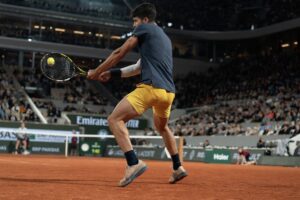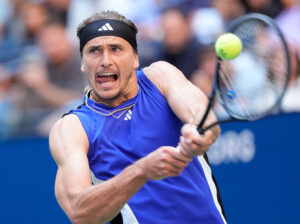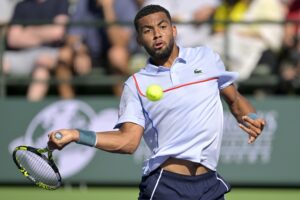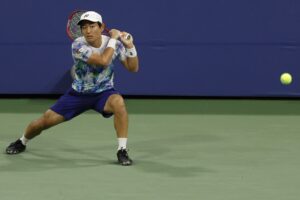Countdown to Melbourne: With the 2018 Australian Open now just a few days away, our resident tennis historian, Martin Keady, takes a look back at the five finest Australian Open Women’s Champions.
For much of the 20th century, the Australian Open was very much the poor, unloved and frankly distant relation of the other Majors. As late as the 1970s, many of the world’s best tennis players did not even make the long journey down under to compete at the tournament. Although that situation has now completely changed, with the Australian Open not only marking the start of the tennis year but in many ways the start of the whole sporting year, many of the greatest Australian Open champions in both the men’s and the women’s singles remain native Australians. That is especially true on the women’s side, where no fewer than four of the five greatest Australian Open champions (at least as judged by the simple measure of who has won the tournament most often) are Australians.
Here are the five finest Australian Open Women’s Champions.
- EVONNE GOOLAGONG CAWLEY (Winner of four Australian Opens: 1974, 1975, 1976 and 1977)
Evonne Goolagong Cawley is not alone in having won the Australian Open four times. Both Steffi Graf and Monica Seles also triumphed in Melbourne on four occasions. However, the fact that Goolagong Cawley was also runner-up for three successive years between 1971 and 1973 before finally winning the event for the first time in 1974 just gives her the edge over the great German and Yugoslav-American.
Goolagong Cawley, of course, was the most native of native Australians, being an Aboriginal. Nearly thirty years before Cathy Freeman, the great 400 metres runner, became the poster girl for the 2000 Sydney Olympics, Goolagong Cawley had already become world famous for being one of the world’s greatest tennis players, in the process drawing global attention to the plight of Australia’s native people and indeed native peoples everywhere.
Goolagong Cawley had initially broken through as a Major winner in 1971, not only by winning the Wimbledon women’s singles title that year but by doing so in spectacular style, as she defeated her already legendary compatriot, Margaret Court, in straight sets, 6-4, 6-1. This gave Goolagong Cawley a measure of revenge after she had lost the Australian Open women’s singles final to Court in January that year. (The Australian Open has moved around the tennis calendar far more than the other three Majors, before finally settling permanently on a January start in 1987.)
Goolagong Cawley would lose another two Australian Open finals in succession – first to Britain’s Virginia Wade in 1972 and then again to Court in 1973 – before she finally won her first Australian Open title in 1974, when she defeated the young Chris Evert in the final. But once she had finally won in Melbourne, there was seemingly no stopping her, as she won a hat-trick of titles between 1974 and 1976, and then won a fourth title in 1977.
The reason that Goolagong Cawley is not regarded as a straight four-time winner in succession is that extraordinarily there were two Australian Opens in 1977: one played in January, which was won by another Australian, Kerry Melville Reid, after Goolagong Cawley decided not to compete; and one in December, which Goolagong Cawley did enter and duly won. The reason that there were two Australian Opens that year was because the tournament organisers wanted to move the tournament from its traditional January start date to December, and consequently thought it was best just to have two tournaments in the same year. (The Australian Open remained in December until 1985, when it was then moved back to January for 1987, meaning there was no 1986 Australian Open at all.)
Nevertheless, mere statistics (and, frankly, rather tedious discussion of calendar shifts) do not do justice to the grace and power of Goolagong Cawley’s game. She combined great mobility with devastating shot-making (including with her one-handed backhand) and consequently became not only a powerful symbol of native peoples around the world, at a time when they were often being oppressed, but one of the greatest women tennis players of the 1970s.
- DAPHNE AKHURST COZENS (Winner of five Australian titles: 1925, 1926, 1928, 1929 and 1930)
The next two entrants on this list are not nearly as “storied” (as American sports writers would put it) as Goolagong Cawley. Indeed, they are often forgotten today. Nevertheless, their achievements in winning five and six Australian Opens respectively should not be dismissed, because even if the competition they faced was largely that provided by other Australian women, that competition – at a time when Australia, along with America, was one of the two superpowers in tennis – was still fierce.
Daphne Akhurst Cozens won five Australian titles, one more than Goolagong Cawley. Unlike Goolagong Cawley, who, as an Aboriginal, was initially very much an “outsider” in Australian tennis and society, Daphne Akhurst (as she was before marrying Royston Stuckey Cozens, a tobacco tycoon) was almost the embodiment of the old, white and largely Anglicised Australia. She won her first Australian title (or “Australasian Championships”, as it was called then) in 1925, beating yet another Australian woman, Esna Boyd, in the final. Then, in a move that is a testament to Australia’s geographical and sporting separation from the rest of the world before World War Two, she became part of what was the first team of Australian women tennis players to tour Europe, when tennis players, like cricketers and rugby players today, still went “on tour”.
Akhurst Cozens only made one other trip to Europe, in 1928, reaching the quarterfinals at both Wimbledon and Roland Garros, and she never competed in the US Championships at all. On home grass, however, she was virtually unbeatable, winning four more Australian titles, including a hat-trick between 1928 and 1930. Indeed, her only defeat in five years at the Australian Championship came in 1927, when she surprisingly lost to another fellow Australian, Dorothy Weston, in the second round.
Finally, having begun by saying that Akhurst Cozens’s life and career were not nearly as memorable as those of Goolagong Cawley, it must be emphasised that the end of her life was all too memorable, indeed tragic. Having retired from tennis to marry and start a family, she died in 1933 from an ectopic pregnancy (whereby the embryo attaches outside the uterus) when she was only 29. Thus she joined the list of other great women tennis players who died tragically young, a list headed by the truly great Suzanne Lenglen, who died of leukaemia at the age of 39. Today, Akhurst Cozens’s memory lives on in the title of the trophy that has been awarded to the winner of the Australian women’s title ever since her death, the Daphne Akhurst Memorial Cup.
- NANCYE WYNNE BOLTON (Winner of six Australian titles: 1937, 1940, 1946, 1947, 1948 and 1951)
Nancye Wynne Bolton might have headed this list if she had not shared the unfortunate fate of so many mid-20th century sportsmen and women in having her career interrupted by World War Two. However, she would have cared little about that, because the war cost her far more than titles. Her husband, George Bolton, a British pilot who she married in 1940, was killed while on a bombing raid over Germany in 1942. Thus, personal tragedy put into context any sporting frustration she may have experienced.
Nancye Wynne (as she was then) won her first Australian title in 1937, when she was only 21 and she would win another title in 1940, before Australia suspended its tennis championships until the end of World War Two. When the tournament recommenced in 1946, Wynne Bolton (as she had become in the intervening years) made up for lost time by winning three titles in a row, and added a sixth in 1951. It demonstrates both the isolation of Australian tennis at this time and its strength in depth that in all six of her winning finals she defeated fellow Australians, including Thelma Dorothy Coyne Long, who twice won the Australian title herself.
It is also worth pointing out that Wynne Bolton’s career shows how Australian tennis gradually began to emerge from its isolation towards the mid-point of the 20th century. Unlike Akhurst Cozens, who never even competed in the US, she was runner-up at the 1938 US Open to the marvellously named (and indeed marvellously talented) Alice Marble. Although Wynne Bolton would not reach another Major final abroad, she would eventually be followed by the great post-war Australian tennis players, such as Roy Emerson, Rod Laver and Margaret Court, who would go on to dominate not just their home tournament but tennis around the world.
- SERENA WILLIAMS (Winner of seven Australian Opens: 2003, 2005, 2007, 2009, 2010, 2015 and 2017)
When Serena Williams withdrew this week from the 2018 Australian Open, her assault on Margaret Court’s all-time record of 24 Grand Slam singles titles was temporarily halted. She is currently on 23, with the last addition to her Majors list having come last year in Melbourne, when she defeated her sister, Venus, even though she was already pregnant with her daughter, Alexis Olympia. Whether she finally beats Court’s record will probably depend as much on the demands of motherhood as the demands placed upon her game by opposing players. However, even if Serena ended her career now, in the eyes of many tennis writers and former great players, including John McEnroe, she is undoubtedly the finest female tennis player ever, and her record at the Australian Open is one of the cornerstones of her success.
When Serena announced the name of her new daughter in the autumn of last year, she joked that the initials – A.O. – matched those of the Australian Open. She has certainly come to love the tournament, having initially struggled there early in her career. Indeed, along with Wimbledon, it is the Grand Slam that she has won most often.
Her first triumph in Melbourne crowned the early part of her career, as her 2003 win (which, like her win in 2017, was against sister Venus), sealed the first of her two “Serena Slams”, whereby she held all four Major titles at the same time. (She was to repeat the remarkable feat at Wimbledon in 2015.) Although she may never have won an actual Grand Slam – i.e. all four Majors in the same calendar year – her achievement of two such all-conquering feats is unique in the Open Era. Even Novak Djokovic could only achieve a similar “Nole Slam” once in his own imperious phase between 2011 and 2016.
It could be argued that it is surprising that Serena has not already passed Court’s record, given that she has had all the physical attributes (especially the finest ever serve in the women’s game ever and almost equally powerful groundstrokes) to do so. However, in reflecting on her decision not to play at this year’s Australian Open, she may have provided an explanation as to why she has not done so. She admitted that in the past she has felt “nervous” when on the verge of winning. That was never truer than at the 2015 US Open, where, on the verge of completing a genuine calendar Grand Slam, she astonishingly lost in the semi-final to the relatively unheralded Italian, Roberta Vinci, in what is probably the single most shocking result in all of tennis history. However, the fact that she now says becoming a mother has made her “less nervous” about her game is a warning to all the other women on tour that in future she may become an even better player than she has been before.
- MARGARET COURT (Winner of 11 Australian Opens and Championships: 1960, 1961, 1962, 1963, 1964, 1965, 1966, 1969, 1970, 1971 and 1973)
Serena Williams may ultimately overcome Margaret Court’s overall Major record, but it is unlikely that she will ever overtake Court as “the winningest woman” at the Australian Open. Court won 11 Australian titles in 14 years, including a truly magnificent seven in a row between 1960 and 1966, which remains a record for any Major in either the men’s or women’s game. She also did so while straddling two different eras in the sport: the supposedly “amateur” era (which was actually a “shamateur” era of surreptitious payments by its end); and the Open era, since 1968.
However, Court’s reputation is now being called into question, not for her achievements on the court but because of her controversial remarks off it. Only today, Billie Jean King, a near-contemporary of Court and one of her greatest rivals, has argued that the “Margaret Court Arena” in Melbourne should be renamed because of Court’s vocal opposition to gay marriage and her general condemnation of the LGBT community, of which King is a member. As King said of the show court: “I’m a gay woman. If I were playing today, I would not play on it”. Others have gone even further and argued that Court’s own sporting achievements should be cast in a new light, given her increasingly intransigent attitudes towards others since becoming an evangelical Christian Minister.
However, Martina Navratilova, who is herself a great gay female champion, has insisted that, although she too believes that the Margaret Court Arena should be renamed, Court’s tennis credentials should not be called into question. As Navratilova put it, “You keep her in the Hall of Fame. That Margaret has definitely homophobic views does not take away those accomplishments, no doubt about that.”
Nevertheless, in the future it is possible that Court might end up sharing the ignominious fate of another former tennis great, Bill Tilden, albeit for completely different reasons. Tilden, who remains the man who has won the US Open the most often (six times), spectacularly fell from grace after his retirement from the game, when he was sentenced to jail in 1946 for having sex with an under-age boy. Even today, more than seventy years on and long after the law on homosexuality has been revised in most countries, Tilden’s reputation has still not been completely rehabilitated.
There are many experienced tennis watchers and commentators who would argue that Margaret Court and Bill Tilden are still the greatest ever female and male tennis players. In the future, though, both of them might end up being largely “written out” of tennis history, not because of any doubts about their tennis ability but because of questions about their personal conduct and comments. Consequently, a great gay male player and an equally great anti-gay female player might find themselves linked together in a curious tennis hall of shame.
Main Photo:






